Looking for a student learning guide? It’s linked in the main menu for your course. Use the “Courses” menu above.
1. Plants bring matter and energy into ecosystems

Almost every ecosystem on our planet is powered by light energy from the sun. Through photosynthesis, organisms like plants convert light energy into chemical energy, primarily in the form of carbohydrates.
The ability of plants to produce chemical energy makes them ecological producers. Producers are also called autotrophs. The term autotroph means self-feeder (“auto” means “self,” and “troph” refers to “food” or “nourishment”).
If you think about it, feeding themselves is exactly what plants do. In the cells in their leaves, chloroplasts make food through photosynthesis. Here’s the equation for photosynthesis:
6CO2 + 6H2O + light energy→ C6H12O6 + 6O2
In plain English (without the numbers)
carbon dioxide + water → glucose + oxygen
C6H12O6 (glucose) is a simple sugar that plants use to stay alive, grow, and reproduce. All of the more complex molecules that plants are made of — carbohydrates like starch and cellulose, fats and oils, proteins, and nucleic acids — are reassembled from glucose.
To power their own life processes, plants use some of the glucose as the starting point for cellular respiration.
Here’s the equation for cellular respiration:
C6H12O6 + 6O2 → energy(ATP) + 6CO2 + 6H2O
In plain English (without the numbers) that means
glucose + oxygen → carbon dioxide + water + energy
The energy is in the form of ATP. The ATP is used to power all of a plant’s life processes: growth, cell division, repair, reproduction, etc.
Since we humans live on land, we generally think of autotrophs as being plants. But two other autotrophs are important to know about: algae, and cyanobacteria.
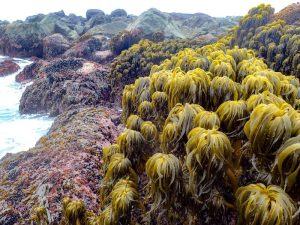
Algae include what we commonly call seaweed.
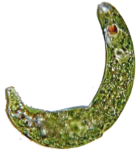
Seaweeds are multicellular, but other algae, like the euglena shown at right, consist of only one cell.
All algae are eukaryotic, with complex cells that include chloroplasts.
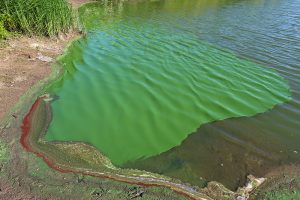
Cyanobacteria are prokaryotic cells that perform photosynthesis. Cyanobacteria are microscopic, but you can see them as a green film on the surface of standing water. Cyanobacteria have been around for 3.5 billion years. Their photosynthetic activity is responsible for the Earth’s oxygen-rich atmosphere.
Let’s consolidate what’s above with a few flashcards.
[qdeck qrecord_id=”sciencemusicvideosMeister1961-Energy From Plants (in Food Chains, HS)”]
[h]Energy from plants
[i]
[q]Almost every ecosystem on our planet is powered by ___________ energy from the __________.
[a]Almost every ecosystem on our planet is powered by light energy from the sun.
[q]Through __________, plants convert light energy into ____________ energy. That energy is primarily in the form of _____________.
[a]Through photosynthesis, plants convert light energy into chemical energy. That energy is primarily in the form of carbohydrates.
[q]The ability of plants to produce chemical energy makes them ecological ___________.
[a]The ability of plants to produce chemical energy makes them ecological producers.
[q]Ecological producers like plants, algae, and cyanobacteria are all a_________________ (begins with “a”).
[a]Ecological producers like plants, algae, and cyanobacteria are all autotrophs.
[q]Autotroph means ___________.
[a]Autotroph means self-feeder.
[q]What’s the equation for photosynthesis? First, respond with the chemical equation, and then say or write the equation in words.
[a]The equation for photosynthesis is
6CO2 + 6H2O + light energy→ C6H12O6 + 6O2
In plain English (without the numbers)
carbon dioxide + water → glucose + oxygen
[q]Plants use the glucose created by photosynthesis for two things: These are
[a]Plants use the glucose created by photosynthesis
- As the starting point for all of the other molecules that they’re made of.
- As the fuel that powers cellular respiration.
[q]What’s the equation for cellular respiration? First, respond with the chemical equation, and then say or write the equation in words.
[a]The equation for cellular respiration is
C6H12O6 + 6O2 → energy(ATP) + 6CO2 + 6H2O
In plain English (without the numbers) that means
glucose + oxygen → carbon dioxide + water + energy
[q]What are the three types of autotrophs?
[a]Three types of autotrophs are plants, algae, and cyanobacteria.
[q]Which autotroph is responsible for producing the oxygen in the atmosphere?
[a]Cyanobacteria are responsible for producing the oxygen in the atmosphere.
[q]If an autotroph is eukaryotic but not a plant, it must be ______________.
[a]If an autotroph is eukaryotic but not a plant, it must be algae.
[q]In the diagram below, what are the flows at “A” and “B?”
[a]In the diagram below, A is photosynthesis, and B is cellular respiration by plants.
[/qdeck]
2. Animals consume the matter and energy captured by plants
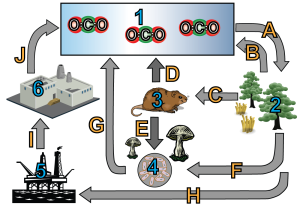 It’s possible to imagine an ecosystem that consists solely of plants (2) and decomposers (4). In that system, photosynthesis would bring carbon dioxide from the atmosphere (1) into plants. When a plant died (F), its body would be decomposed. Decomposition involves cellular respiration (G), which would return the carbon in plants to the atmosphere.
It’s possible to imagine an ecosystem that consists solely of plants (2) and decomposers (4). In that system, photosynthesis would bring carbon dioxide from the atmosphere (1) into plants. When a plant died (F), its body would be decomposed. Decomposition involves cellular respiration (G), which would return the carbon in plants to the atmosphere.
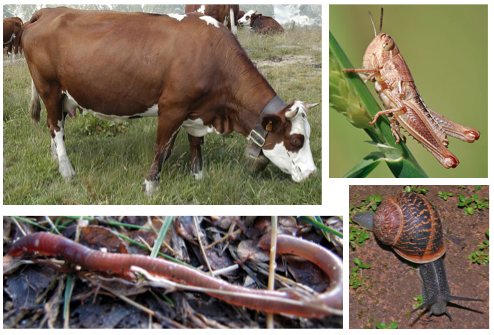
But in nature, some of the matter and energy in plants gets consumed (C) by animals (3) who eat the plants.
Several terms are used to refer to these plant-eaters.
- Primary consumers. “Primary” means “first.” Primary consumers are the first in a chain of animals that consume the matter and energy that’s been produced by plants.
- Herbivores. “Herb” is from a Latin word for “plant;” “Vore” is the same root that’s in the word “devour.”

The carbon cycle diagram above puts all animals together. But what about an animal like a cheetah or a wolf that eats animals that eat plants? Because these animals consume primary consumers, these animal-eaters are known as secondary consumers. They’re also called carnivores (which means “meat-eater”) or predators.
A third-level (tertiary) consumer, would eat a secondary consumer. An animal that eats a third-level consumer would be a fourth-level consumer, and so on.
Use the flashcards below to master the terms above.
[qdeck qrecord_id=”sciencemusicvideosMeister1961-Ecological Consumers (HS)”]
[h]Ecological consumers
[i]
[q]Animals that eat plants are known as ______________ consumers or _________________
[a]Animals that eat plants are known as primary consumers or herbivores.
[q]____________ or ____________ eat primary consumers.
[a]Carnivores or predators eat primary consumers.
[q]When an animal eats a carnivore it’s a ____________ or _________-level consumer.
[a]When an animal eats a carnivore it’s a tertiary or third-level consumer.
[q]In the diagram below, what are the flows at “C” and “D, and what do you call the reservoir at “3?”
[a]In the diagram below, C is consumption, and D is cellular respiration by animals, and 3 is ecological consumers.
[/qdeck]
3. Autotrophs, Heterotrophs, and Food Chains
We saw above that the term for the type of organism that can make its own food is autotroph.
Any organism that doesn’t make its own food is a heterotroph (the word root “hetero-” means “other”). Just think of it this way: whereas plants, algae, and cyanobacteria are autotrophs (and feed themselves), heterotrophs have to eat something else. All animals are heterotrophs. So are fungi, and many bacteria. That means that there are two primary ways of being a heterotroph. Animals are ecological consumers. Fungi and non-photosynthetic bacteria are decomposers.
All of these ways of getting matter and energy make up an ecosystem’s trophic levels. Trophic levels are feeding levels. Organisms at the same trophic level — producers, primary consumers, secondary consumers — are positioned in a similar place in terms of the way that energy flows through an ecosystem.
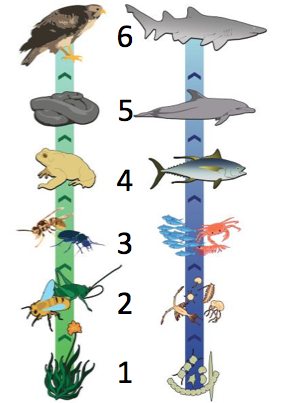 A food chain shows the pathway of matter and energy through a series of organisms. In the food chain on the left, a flowering plant (a producer) is eaten by grasshoppers and bees (the primary consumers), which are eaten by other insects (secondary consumers), which are eaten by frogs (a third-level consumer in this food chain) and so on. The food chain on the right shows a similar transfer of matter and energy for organisms that live in the sea.
A food chain shows the pathway of matter and energy through a series of organisms. In the food chain on the left, a flowering plant (a producer) is eaten by grasshoppers and bees (the primary consumers), which are eaten by other insects (secondary consumers), which are eaten by frogs (a third-level consumer in this food chain) and so on. The food chain on the right shows a similar transfer of matter and energy for organisms that live in the sea.
[qwiz style = “border: 3px solid black; ” qrecord_id=”sciencemusicvideosMeister1961-Food Chains, Checking Understanding (HS)”]
[h] Checking Understanding: Food Chains
Click “start” to begin.
[q] In the diagram, which number refers to a primary consumer?
[c]IDE=[Qq]
[c]wq Ay[Qq]
[c]wqAz[Qq]
[c]wqA0[Qq]
[f]wqBOby4gVGhlIG9yZ2FuaXNtcyBvbiB0aGUgYm90dG9tIG9mIGEgZm9vZCBjaGFpbiBhcmUgYWx3YXlzIHByb2R1Y2Vycy4=[Qq]
[f]wqBOaWNlIGpvYjogdGhlIG9yZ2FuaXNtcyBzaG93biBhdCAmIzgyMjA7MiYjODIyMTsgYXJlIGVhdGluZyB0aGUgcHJvZHVjZXJzLCB3aGljaCBtYWtlcyB0aGVtIHByaW1hcnkgY29uc3VtZXJz[Qq]
[f]IE5vLiBUaGUgb3JnYW5pc21zIHNob3duIGluICYjODIyMDszJiM4MjIxOyBhcmUgc2Vjb25kYXJ5IGNvbnN1bWVycyBvciBjYXJuaXZvcmVzLg==[Qq]
[f]IE5vLiBUaGUgb3JnYW5pc21zIHNob3duIGF0ICYjODIyMDs0JiM4MjIxOyBhcmUgdGhpcmQtbGV2ZWwsIG9yIHRlcnRpYXJ5IGNvbnN1bWVycy4=
Cg==[Qq]
[q] In the diagram, which number refers to producers?
[c]wq Ax[Qq]
[c]wqAy[Qq]
[c]wqAz[Qq]
[c]IDQ=[Qq]
[f]wqBFeGNlbGxlbnQuIExldmVsIDEgY29uc2lzdHMgb2YgcHJvZHVjZXJzLg==[Qq]
[f]wqBOby4gUHJvZHVjZXJzIGFyZSBhbHdheXMgYXQgdGhlIGJvdHRvbSBvZiBhIGZvb2QgY2hhaW4uIExldmVsIDIgY29uc2lzdHMgb2YgcHJpbWFyeSBjb25zdW1lcnMu[Qq]
[f]wqBOby4gUHJvZHVjZXJzIGFyZSBhbHdheXMgYXQgdGhlIGJvdHRvbSBvZiBhIGZvb2QgY2hhaW4uIExldmVsIDMgY29uc2lzdHMgb2Ygc2Vjb25kYXJ5IGNvbnN1bWVycy4=[Qq]
[f]IE5vLiBQcm9kdWNlcnMgYXJlIGFsd2F5cyBhdCB0aGUgYm90dG9tIG9mIGEgZm9vZCBjaGFpbi4gTGV2ZWwgNCBjb25zaXN0cyBvZiB0aGlyZC1sZXZlbCwgb3IgdGVydGlhcnkgY29uc3VtZXJzLg==
Cg==[Qq]
[q] Which is the only level that performs photosynthesis?
[c]wq Ax[Qq]
[c]wqAy[Qq]
[c]wqAz[Qq]
[c]IDQ=[Qq]
[f]wqBFeGNlbGxlbnQuIExldmVsIDEgY29uc2lzdHMgb2YgcHJvZHVjZXJzLiBPbmx5IHByb2R1Y2VycyBwZXJmb3JtIHBob3Rvc3ludGhlc2lzLg==[Qq]
[f]IE5vLiBMZXZlbCAyIGNvbnNpc3RzIG9mIHByaW1hcnkgY29uc3VtZXJzLiBPbmx5IHByb2R1Y2VycyBwZXJmb3JtIHBob3Rvc3ludGhlc2lzLg==[Qq]
[f]wqBOby7CoExldmVsIDMgY29uc2lzdHMgb2Ygc2Vjb25kYXJ5IGNvbnN1bWVycy7CoE9ubHkgcHJvZHVjZXJzIHBlcmZvcm0gcGhvdG9zeW50aGVzaXMu[Qq]
[f]wqBOby7CoExldmVsIDTCoGNvbnNpc3RzIG9mIHRoaXJkLWxldmVswqBjb25zdW1lcnMuwqBPbmx5IHByb2R1Y2VycyBwZXJmb3JtIHBob3Rvc3ludGhlc2lzLg==[Qq]
[q]Producers like plants, algae, and cyanobacteria are also called [hangman], which means “self-feeder.”
[c]YXV0b3Ryb3Bocw==[Qq]
[q]An animal that eats a plant is known as a [hangman] consumer or a(n) [hangman]
[c]cHJpbWFyeQ==[Qq]
[c]aGVyYml2b3Jl[Qq]
[q]Producers are capable of feeding themselves because they can perform [hangman], the process that involves capturing the sun’s energy
[c]cGhvdG9zeW50aGVzaXM=[Qq]
[q labels = “top”]In photosynthesis
_______ + 6H2O + light energy→ ___________+ 6O2
In plain English (without the numbers)
carbon dioxide + ___________ → glucose + ____________
[l]oxygen
[fx] No. Please try again.
[f*] Excellent!
[l]water
[fx] No. Please try again.
[f*] Good!
[l]C6H12O6
[fx] No, that’s not correct. Please try again.
[f*] Correct!
[l]6CO2
[fx] No, that’s not correct. Please try again.
[f*] Great!
[q]The flow of matter and energy from one organism to the next within an ecosystem is called a [hangman] [hangman]
[c]Zm9vZA==[Qq]
[c]Y2hhaW4=[Qq]
[q labels = “top”]Label some of the trophic levels in the food chain below.
[l]primary consumer
[fx] No, that’s not correct. Please try again.
[f*] Great!
[l]producer
[fx] No, that’s not correct. Please try again.
[f*] Good!
[l]secondary consumer
[fx] No. Please try again.
[f*] Great!
[l]Third-level consumer
[fx] No, that’s not correct. Please try again.
[f*] Great!
[x] If you want to take this quiz again, click the button below. Otherwise, continue reading.
[restart]
[/qwiz]
4. Food Webs
A food web shows all the interconnected food chains in an ecosystem. In the food web below, you can start from the phytoplankton (floating organisms that do photosynthesis), and follow the pathway of matter and energy to the bivalves (organisms like clams), to sea ducks, to the bald eagle. That is only one of several food chains that you could follow in this food web. See if you can find two or three others.
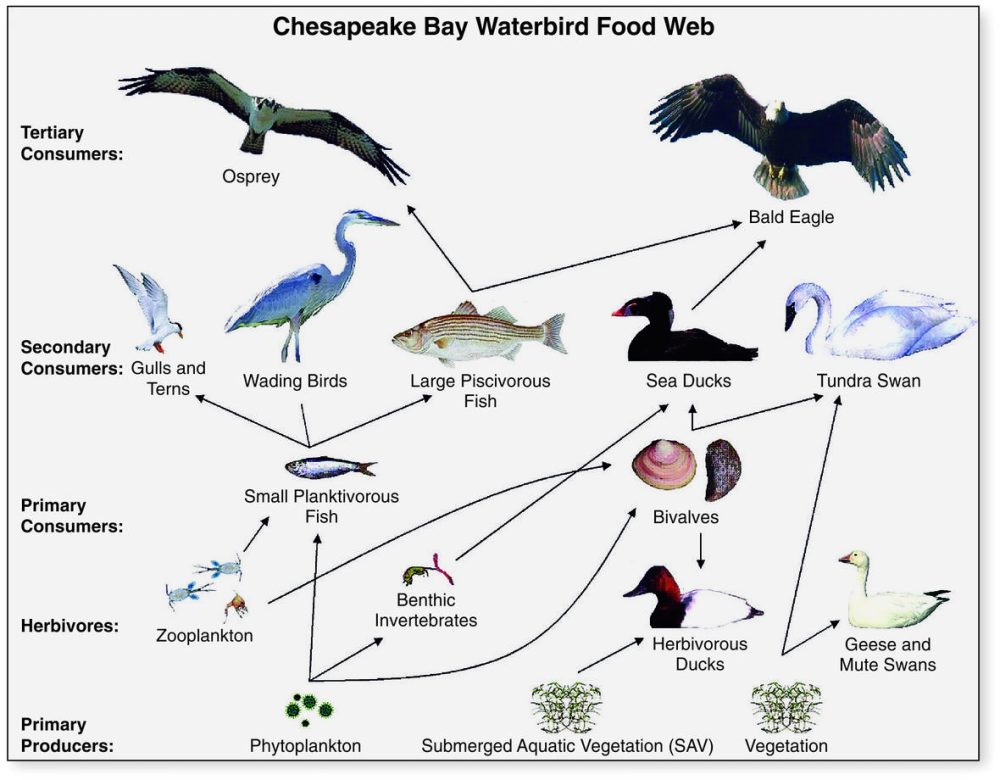
5. Other Ways of Getting Food: Omnivores, Scavengers, Decomposers, and Parasites
Many animals can’t be neatly classified as either primary or secondary consumers: the way they make a living (also known as their ecological niche) involves eating at multiple levels. A grizzly bear, for example, is an omnivore. It eats plants such as berries, but it will also hunt for rodents, rabbits, and salmon. Humans, of course, are also omnivores.
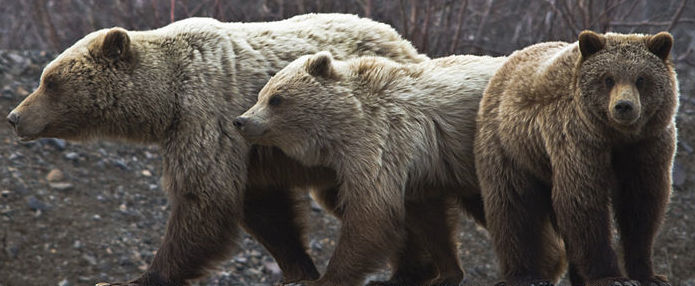
Scavengers eat recently killed animals. Vultures are scavengers. So are bald eagles. Hyenas are both carnivores and scavengers.
.jpg)
Many organisms participate in consuming and breaking down dead organic matter, which is a process that occurs in many stages. Decomposers, primarily fungi and bacteria, play the final role in this process, breaking down dead material into simple molecules that can re-enter biogeochemical cycles like the carbon cycle.
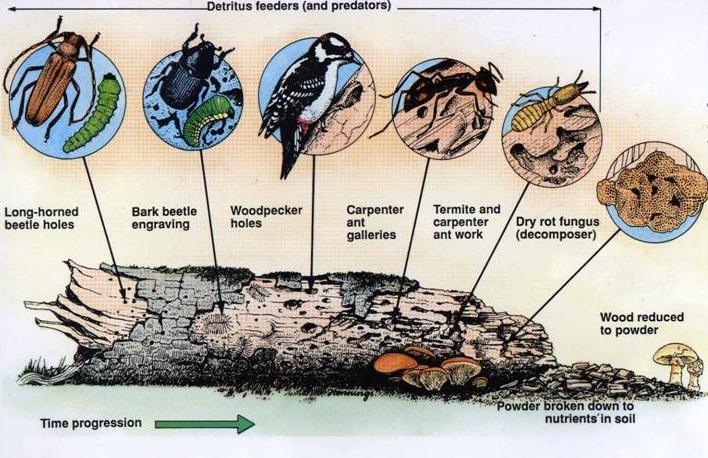
Finally, parasites live inside and consume living prey. Some parasites can be as large as the tapeworm (shown below), which infects the muscle tissue of pigs and cows, and the intestines of humans. In humans, tapeworms can grow up to be up to twenty feet long. However, many more parasites are microscopic, like the parasitic bacteria that cause diseases like diphtheria and cholera, or viruses, which parasitize cells.
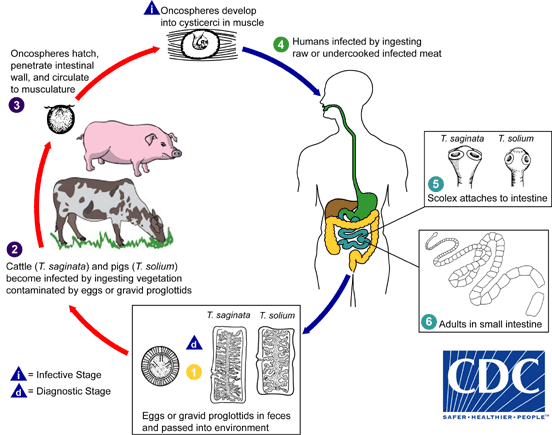
6. Flashcards: Food chains, Food Webs, Trophic Levels
At this point, you should be able to describe how food chains and food webs work, and the basic roles that organisms play within food chains and webs. This includes understanding the following terms:
- food chain
- food web
- producer
- primary consumer
- herbivore
- autotroph
- heterotroph
- secondary consumer
- carnivore
- predator
- trophic level
- omnivore
- decomposer
- scavenger
- parasite
To help you master these terms, spend as much time as you need working through these flashcards:
[qdeck style=”border: 2px solid black;” random = “false” qrecord_id=”sciencemusicvideosMeister1961-Food Chains, Food Webs, Trophic Levels (HS)”]
[h] Flashcards: Food Chains and Food Webs
[i] In the flashcards below, you have the option of typing in the answer. That makes the cards more challenging. However you proceed, the goal is to be able to respond to each card with confidence and accuracy.
[start]
[!] Card 1+++++++++++++++++++++++[/!]
[q] A _____ _____ is one pathway showing the flow of energy and matter through an ecosystem.
[textentry]
[a] A food chain is one pathway showing the flow of energy and matter through an ecosystem.
[!] Card 2+++++++++++++++++++++++[/!]
[q] All of the food chains in an ecosystem make up a ______ ______.
[textentry]
[a] All of the food chains in an ecosystem make up a food web.
[!] Card 2b+++++++++++++++++++++++[/!]
[q] All of the food chains in an ________ make up a food web.
[textentry]
[a] All of the food chains in an ecosystem make up a food web.
[!] Card 3+++++++++++++++++++++++[/!]
[q] A organism in an ecosystem, typically a plant, that creates food through photosynthesis is known as a ________.
[textentry]
[a] A organism in an ecosystem, typically a plant, that creates food through photosynthesis is known as a producer.
[!] Card 3b+++++++++++++++++++++++[/!]
[q] A organism in an ecosystem, typically a plant, that creates food through ________ is known as a producer.
[textentry]
[a] A organism in an ecosystem, typically a plant, that creates food through photosynthesis is known as a producer.
[!] Card 4+++++++++++++++++++++++[/!]
[q] _______ consumers are organisms that eat producers.
[textentry]
[a] Primary consumers are organisms that eat producers.
[!] Card 5+++++++++++++++++++++++[/!]
[q] _______ are also known as primary consumers.
[textentry]
[a] Herbivores are also known as primary consumers.
[!] Card 5b+++++++++++++++++++++++[/!]
[q] Herbivores are also known as _______ consumers.
[textentry]
[a] Herbivores are also known as primary consumers.
[!] Card 6+++++++++++++++++++++++[/!]
[q] ________ are organisms that can feed themselves by making their own food.
[textentry]
[a] Autotrophs are organisms that can feed themselves by making their own food.
[!] Card 7+++++++++++++++++++++++[/!]
[q] All organisms that eat other organisms (as opposed to making their own food) are __________.
[textentry]
[a] All organisms that eat other organisms (as opposed to making their own food) are heterotrophs.
[!] Card 8+++++++++++++++++++++++[/!]
[q] A _______ _______ is an organism that eats a primary consumer.
[textentry]
[a] A secondary consumer is an organism that eats a primary consumer.
[!] Card 8b+++++++++++++++++++++++[/!]
[q] ________, like wolves, are also known as secondary consumers.
[textentry]
[a] Carnivores, like wolves, are also known as secondary consumers.
[!] Card 10+++++++++++++++++++++++[/!]
[q] A ________ is an animal that preys on other animals. In terms of trophic levels, these organisms are secondary or tertiary (third-level) consumers
[textentry]
[a] A predator is an animal that preys on other animals. In terms of trophic levels, these organisms are secondary or tertiary (third-level) consumers. (note that “carnivore” is a perfectly good response here).
[!] Card 11+++++++++++++++++++++++[/!]
[q] An _________ is an animal that eats both as an herbivore (or primary consumer) and as a carnivore (or secondary consumer).
[textentry]
[a] An omnivore is an animal that eats both as an herbivore (or primary consumer) and as a carnivore (or secondary consumer).
[!] Card 12+++++++++++++++++++++++[/!]
[q] Producer, primary consumer, and secondary consumer: all of these are examples of ________ levels.
[textentry]
[a] Producer, primary consumer, and secondary consumer: all of these are examples of trophic levels.
[!] Card 13+++++++++++++++++++++++[/!]
[q] A _________ is an organism that gets energy by breaking down dead material into simple molecules that can re-enter biogeochemical cycles.
[textentry]
[a] A decomposer is an organism that gets energy by breaking down dead material into simple molecules that can re-enter biogeochemical cycles.
[!] Card 13a+++++++++++++++++++++++[/!]
[q] A decomposer is an organism that gets energy by breaking down _______ material into simple molecules that can re-enter biogeochemical cycles.
[textentry]
[a] A decomposer is an organism that gets energy by breaking down dead material into simple molecules that can re-enter biogeochemical cycles.
[!] Card 13b+++++++++++++++++++++++[/!]
[q] A decomposer is an organism that gets energy by breaking down dead material into simple molecules that can re-enter __________ cycles.
[textentry]
[a] A decomposer is an organism that gets energy by breaking down dead material into simple molecules that can re-enter biogeochemical cycles.
[!] Card 14+++++++++++++++++++++++[/!]
[q] Whereas carnivores kill animals and eat them, ________ eat the remains of animals that other organisms have killed.
[textentry]
[a] Whereas carnivores kill animals and eat them, scavengers eat the remains of animals that other organisms have killed.
[!] Card 14a+++++++++++++++++++++++[/!]
[q] Whereas ________ kill animals and eat them, scavengers eat the remains of animals that other organisms have killed.
[textentry]
[a] Whereas carnivores kill animals and eat them, scavengers eat the remains of animals that other organisms have killed.
[!] Card 15+++++++++++++++++++++++[/!]
[q] A _________ is an organism that lives inside of (or on) a living host, consuming that host while it’s still alive.
[textentry]
[a] A parasite is an organism that lives inside of (or on) a living host, consuming that host while it’s still alive.
[x] If you want more practice, please press the restart button below. Otherwise, continue to the final quiz.
[restart]
[/qdeck]
7. Quiz: Food Chains, Food Webs, Trophic Levels, etc.
[qwiz style = “border: 3px solid black;”random = “false” qrecord_id=”sciencemusicvideosMeister1961-Food Chains, Food Webs,Cumulative Quiz”]
[h] QUIZ: Food Chains and Food Webs
[i] This quiz covers key concepts and terms related to food chains and food webs
[q] What is the source of energy in almost all ecosystems?
[c]IEFUUA==[Qq]
[c]IHN1bm xpZ2h0[Qq]
[c]IHdhdGVy[Qq]
[c]IGdsdWNvc2U=[Qq]
[f]IE5vLiBBVFAgaXMgdGhlIGVuZXJneSBzb3VyY2Ugd2l0aGluIGNlbGxzLiBCdXQgY2VsbHMgcG93ZXIgdGhlaXIgQVRQIHByb2R1Y3Rpb24gdGhyb3VnaCBjZWxsdWxhciByZXNwaXJhdGlvbiwgdXNpbmcgZ2x1Y29zZSBhcyBhIGZ1ZWwuIEdsdWNvc2UgaXMgY3JlYXRlZCBieSBwaG90b3N5bnRoZXNpcy4gV2hhdCBwb3dlcnMgcGhvdG9zeW50aGVzaXM/[Qq]
[f]IFllcy4gTGlnaHQgZnJvbSB0aGUgc3VuIGlzIHRoZSBlbmVyZ3kgc291cmNlIGZvciBhbG1vc3QgYWxsIGVjb3N5c3RlbXMu[Qq]
[f]IE5vLiBXYXRlciBtYWtlcyB1cCBtb3N0IG9mIHRoZSBtYXNzIG9mIG1vc3QgbGl2aW5nIHRoaW5ncywgYnV0IGl04oCZcyBub3QgYW4gZW5lcmd5IHNvdXJjZS4gVGhlIGNoZW1pY2FsIGVuZXJneSBmb3IgbGlmZSBjb21lcyBmcm9tIGNhcmJvaHlkcmF0ZXMsIHdoaWNoIGFyZSBtYWRlIGJ5IHBob3Rvc3ludGhlc2lzLiBXaGF0IHBvd2VycyBwaG90b3N5bnRoZXNpcz8=[Qq]
[f]IE5vLiBHbHVjb3NlIGlzIGEga2V5IGZvcm0gb2YgY2hlbWljYWwgZW5lcmd5LCBidXQgZ2x1Y29zZSBpdHNlbGYgaXMgbWFkZSBieSBwaG90b3N5bnRoZXNpcy4gV2hhdCBwb3dlcnMgcGhvdG9zeW50aGVzaXM/
Cg==Jm5ic3A7
Cg==[Qq]
[q] The organisms that create the food that supports ecosystems are known as
[c]IGhlcmJpdm9yZXM=[Qq]
[c]IHByb2R1 Y2Vycw==[Qq]
[c]IGNvbnN1bWVycw==[Qq]
[c]IGRlY29tcG9zZXJzwqA=[Qq]
[f]IE5vLiBIZXJiaXZvcmVzIGVhdCBwbGFudHMuIEVjb2xvZ2ljYWxseSwgd2hhdCBhcmUgcGxhbnRzPw==[Qq]
[f]IFllcy4gVGhlIHBsYW50cyB0aGF0IGNyZWF0ZSB0aGUgZm9vZCB0aGF0IHN1cHBvcnRzIGFuIGVjb3N5c3RlbSBhcmUga25vd24gYXMgcHJvZHVjZXJzLg==[Qq]
[f]IE5vLiBDb25zdW1lcnMgY29uc3VtZSBwbGFudHMuIFBsYW50cyBhcmUgYWxzbyBrbm93biBhcyYjODIzMDs=[Qq]
[f]IE5vLiBEZWNvbXBvc2VycyBhcmUgZXNzZW50aWFsIGZvciBicmVha2luZyBkb3duIG9yZ2FuaWMgbWF0dGVyIGludG8gYSBmb3JtIHRoYXQgb3RoZXIgb3JnYW5pc21zIGNhbiByZXVzZS4gQnV0IHdoYXTigJlzIA==dGhlIG5hbWUgb2YgdGhlIG9yZ2FuaXNtcyB0aGF0IG1ha2UgdGhlIGZvb2Q/
Cg==Jm5ic3A7
Cg==[Qq]
[q] One of these things is not like the other ones. Which one doesn’t fit?
[c]IFBsYW50[Qq]
[c]IFByb2R1Y2Vy[Qq]
[c]IEhldGVy b3Ryb3Bo[Qq]
[c]IGF1dG90cm9waA==[Qq]
[f]IE5vLiBUaGUgdW5pZnlpbmcgY29uY2VwdCBoZXJlIGlzIGJlaW5nIGFibGUgdG8gcHJvZHVjZSB5b3VyIG93biBmb29kLiBQbGFudHMgZmVlZCB0aGVtc2VsdmVzIHRocm91Z2ggcGhvdG9zeW50aGVzaXMuIFdoaWNoIHRlcm0gcmVmZXJzIHRvIG9yZ2FuaXNtcyB0aGF0IGNhbuKAmXQ/[Qq]
[f]IE5vLiBUaGUgdW5pZnlpbmcgY29uY2VwdCBoZXJlIGlzIGJlaW5nIGFibGUgdG8gcHJvZHVjZSB5b3VyIG93biBmb29kLiDigJhQcm9kdWNlcnPigJkgcHJvZHVjZSBmb29kLiBXaGljaCB0ZXJtIHJlZmVycyB0byBvcmdhbmlzbXMgdGhhdCBjYW7igJl0Pw==[Qq]
[f]IFllcy4gSGV0ZXJvdHJvcGhzIG5lZWQgdG8gYWNxdWlyZSBlbmVyZ3kgZnJvbSBvdGhlciBvcmdhbmlzbXMuIOKAmEhldGVyb3Ryb3Bo4oCZIG1lYW5zIOKAmG90aGVyLWZlZWRlci7igJkgQWxsIHRoZSBvdGhlciB0ZXJtcyBhcmUgZm9yIG9yZ2FuaXNtcyB0aGF0IG1ha2UgdGhlaXIgb3duIGZvb2Qu[Qq]
[f]IE5vLiBUaGUgdW5pZnlpbmcgY29uY2VwdCBoZXJlIGlzIGJlaW5nIGFibGUgdG8gcHJvZHVjZSB5b3VyIG93biBmb29kLiDigJhBdXRvdHJvcGjigJkgbWVhbnMg4oCYc2VsZi1mZWVkZXIu4oCZIFdoaWNoIHRlcm0gcmVmZXJzIHRvIG9yZ2FuaXNtcyB0aGF0IGNhbuKAmXQgZmVlZCB0aGVtc2VsdmVzPw==
Cg==[Qq]
[q] One of these things is not like the other ones. Which one doesn’t fit?
[c]IFBs YW50[Qq]
[c]IENvbnN1bWVy[Qq]
[c]IEhldGVyb3Ryb3Bo[Qq]
[c]IEFuaW1hbA==[Qq]
[f]IFllcy4gQWxsIHRoZSBvdGhlciB0ZXJtcyBhcmUgdW5pZmllZCBieSBuZWVkaW5nIHRvIGFjcXVpcmUgZW5lcmd5IGZyb20gYW5vdGhlciBvcmdhbmlzbS4gUGxhbnRzLCB3aGljaCBjYW4gcGVyZm9ybSBwaG90b3N5bnRoZXNpcywgZmVlZCB0aGVtc2VsdmVzLg==[Qq]
[f]IE5vLiBUaGUgdW5pZnlpbmcgY29uY2VwdCBoZXJlIGlzIG5lZWRpbmcgdG8gYWNxdWlyZSBlbmVyZ3kgZnJvbSBhbm90aGVyIG9yZ2FuaXNtLiBDb25zdW1lcnMgbmVlZCB0byBjb25zdW1lIHBsYW50cyAob3IgYW5pbWFscykgdG8gc3RheSBhbGl2ZS4gV2hpY2ggb2YgdGhlIGxpc3RlZCBjYXRlZ29yaWVzIGRvZXMgbm90IG5lZWQgdG8gY29uc3VtZSBvdGhlciBvcmdhbmlzbXM/[Qq]
[f]IE5vLiBUaGUgdW5pZnlpbmcgY29uY2VwdCBoZXJlIGlzIG5lZWRpbmcgdG8gYWNxdWlyZSBlbmVyZ3kgZnJvbSBhbm90aGVyIG9yZ2FuaXNtLiDigJhIZXRlcm90cm9waOKAmSBtZWFucyDigJhvdGhlciBmZWVkZXIu4oCZIEhldGVyb3Ryb3BocyBuZWVkIHRvIGNvbnN1bWUgcGxhbnRzIChvciBhbmltYWxzKSB0byBzdGF5IGFsaXZlLiBXaGljaCBvZiB0aGUgbGlzdGVkIGNhdGVnb3JpZXMgZG9lcyBub3QgbmVlZCB0byBjb25zdW1lIG90aGVyIG9yZ2FuaXNtcz8=[Qq]
[f]IE5vLiBUaGUgdW5pZnlpbmcgY29uY2VwdCBoZXJlIGlzIG5lZWRpbmcgdG8gYWNxdWlyZSBlbmVyZ3kgZnJvbSBhbm90aGVyIG9yZ2FuaXNtLiBBbmltYWxzIG5lZWQgdG8gY29uc3VtZSBwbGFudHMgKG9yIG90aGVyIGFuaW1hbHMpIHRvIHN0YXkgYWxpdmUuIFdoaWNoIG9mIHRoZSBsaXN0ZWQgY2F0ZWdvcmllcyBkb2VzIG5vdCBuZWVkIHRvIGNvbnN1bWUgb3RoZXIgb3JnYW5pc21zPw==
Cg==[Qq]
[q] The correct chemical equation for photosynthesis is
[c]IEM=Ng==SA==MTI=Tw==[Qq]6 + 6 CO2 + energy (ATP) -> 6CO2 + 6O2
[c]IEM=Ng==SA==MTI=Tw==[Qq]6 + 6O2 -> energy(ATP) + 6CO2 + 6H2O
[c]IDZD Tw==Mg==ICsgNkg=Mg==TyArIEVuZXJneShsaWdodCkgLSZndDsgQw==[Qq]6H12O6 + 6O2
[c]IDZIMg==TyArIDZPMiA=IC0mZ3Q7IDZDTw==[Qq]2 + 6H2O
[f]IE5vLiBUaGUgcmVhY3Rpb24gYWJvdmUgc2hvd3MgZ2x1Y29zZSBiZWluZyBjb21iaW5lZCB3aXRoIGNhcmJvbiBkaW94aWRlLiBJbiBwaG90b3N5bnRoZXNpcywgY2FyYm9uIGRpb3hpZGUgaXMgY29tYmluZWQgd2l0aCB3YXRlciB0byBjcmVhdGUgZ2x1Y29zZSwgd2l0aCBveHlnZW4gcmVsZWFzZWQgYXMgYSBieXByb2R1Y3Qu[Qq]
[f]IE5vLiBJbiBwaG90b3N5bnRoZXNpcywgY2FyYm9uIGRpb3hpZGUgaXMgY29tYmluZWQgd2l0aCB3YXRlciB0byBjcmVhdGUgZ2x1Y29zZSwgd2l0aCBveHlnZW4gcmVsZWFzZWQgYXMgYSBieXByb2R1Y3Qu[Qq]
[f]IFllcy4gSW4gcGhvdG9zeW50aGVzaXMsIGNhcmJvbiBkaW94aWRlIGlzIGNvbWJpbmVkIHdpdGggd2F0ZXIgdG8gY3JlYXRlIGdsdWNvc2UsIHdpdGggb3h5Z2VuIHJlbGVhc2VkIGFzIGEgYnlwcm9kdWN0Lg==[Qq]
[f]IE5vLiBGaW5kIGEgcmVhY3Rpb24gdGhhdCBiZWdpbnMgd2l0aCBjYXJib24gZGlveGlkZSBhbmQgd2F0ZXIsIGFuZCBjb21iaW5lcyB0aG9zZSBpbnB1dHMgdG8gY3JlYXRlIGdsdWNvc2UsIHdpdGggb3h5Z2VuIHJlbGVhc2VkIGFzIGEgYnlwcm9kdWN0Lg==
Cg==[Qq]
[q] The term that best describes the kind of organism that directly consumes plants is
[c]IHNlY29uZGFyeSBjb25zdW1lcg==[Qq]
[c]IHByaW1hcnkg Y29uc3VtZXI=[Qq]
[c]IGFuaW1hbA==[Qq]
[c]IGhldGVyb3Ryb3Bo[Qq]
[f]IE5vLiBTZWNvbmRhcnkgY29uc3VtZXJzIGNvbnN1bWUgcHJpbWFyeSBjb25zdW1lcnMuIFdoYXQga2luZCBvZiBvcmdhbmlzbSBlYXRzIHBsYW50cz8=[Qq]
[f]IFllcy4gUHJpbWFyeSBjb25zdW1lcnMgYXJlIGhlcmJpdm9yZXMsIGFuZCBlYXQgcGxhbnRzLg==[Qq]
[f]IE5vLiDigJhBbmltYWzigJkgaXMgYSBiaXQgdG9vIGJyb2FkLiBBbmltYWxzIGNhbiBiZSBoZXJiaXZvcmVzIG9yIGNhcm5pdm9yZXMuIFdoYXTigJlzIGEgc3lub255bSBmb3IgaGVyYml2b3JlPw==[Qq]
[f]IE5vLiAmIzgyMjA7SGV0ZXJvdHJvcGgmIzgyMjE7IGlzIHRvbyBicm9hZC4gVG8gYmUgYSBoZXRlcm90cm9waCBtZWFucyBuZWVkaW5nIHRvIGFjcXVpcmUgZm9vZCBmcm9tIGFub3RoZXIgb3JnYW5pc20sIGFzIG9wcG9zZWQgdG8gbWFraW5nIGl0IHlvdXJzZWxmIChsaWtlIGEgcGxhbnQgY2FuKS4gSGV0ZXJvdHJvcGhzIGNhbiBiZSBoZXJiaXZvcmVzLCBjYXJuaXZvcmVzLCBldmVuIGRlY29tcG9zZXJzLiBZb3UgbmVlZCB0byBmaW5kIHRoZSBlY29sb2dpY2FsIGVxdWl2YWxlbnQgZm9yIOKAmGhlcmJpdm9yZS7igJk=
Cg==[Qq]
[q] The correct chemical reaction for cellular respiration is
[c]IEM=Ng==SA==MTI=Tw==[Qq]6 + 6CO2 + energy(ATP) -> 6CO2 + 6O2
[c]IE M=Ng==SA==MTI=Tw==[Qq]6 + 6O2 -> energy(ATP) + 6CO2 + 6H2O
[c]IDZDTw==Mg==ICsgNkg=Mg==TyArIEVuZXJneShsaWdodCkgLSZndDtD[Qq]6H12O6 + 6O2
[c]IDZIMg==TyArIDZPMiA=IC0mZ3Q7IDZDTw==[Qq]2 + 6H2O
[f]IE5vLiBGaW5kIGEgcmVhY3Rpb24gdGhhdCBiZWdpbnMgd2l0aCBnbHVjb3NlLCBjb21iaW5lcyBpdCB3aXRoIG94eWdlbiBhbmQgcmVsZWFzZXMgZW5lcmd5LCBjYXJib24gZGlveGlkZSwgYW5kIHdhdGVyLg==[Qq]
[f]IEV4Y2VsbGVudC4gQ2VsbHVsYXIgcmVzcGlyYXRpb24gYmVnaW5zIHdpdGggZ2x1Y29zZSwgY29tYmluZXMgaXQgd2l0aCBveHlnZW4sIGFuZCByZWxlYXNlcyBlbmVyZ3ksIGNhcmJvbiBkaW94aWRlLCBhbmQgd2F0ZXIu[Qq]
[f]IE5vLiBGaW5kIGEgcmVhY3Rpb24gdGhhdCBiZWdpbnMgd2l0aCBnbHVjb3NlLCBjb21iaW5lcyBpdCB3aXRoIG94eWdlbiBhbmQgcmVsZWFzZXMgZW5lcmd5LCBjYXJib24gZGlveGlkZSwgYW5kIHdhdGVyLiBUaGlzIGVxdWF0aW9uLCBieSB0aGUgd2F5LCBpcyB0aGUgY29ycmVjdCBlcXVhdGlvbiBmb3IgcGhvdG9zeW50aGVzaXMuIElmIHlvdSByZXZlcnNlIHRoZSByZWFjdGlvbiwgeW914oCZbGwgaGF2ZSB0aGUgcmVhY3Rpb24gZm9yIGNlbGx1bGFyIHJlc3BpcmF0aW9uLg==[Qq]
[f]IE5vLiBGaW5kIGEgcmVhY3Rpb24gdGhhdCBiZWdpbnMgd2l0aCBnbHVjb3NlLCBjb21iaW5lcyBpdCB3aXRoIG94eWdlbiBhbmQgcmVsZWFzZXMgZW5lcmd5LCBjYXJib24gZGlveGlkZSwgYW5kIHdhdGVyLg==
Cg==[Qq]
[q] ‘Herbivore’ means the same as
[c]IHNlY29uZGFyeSBjb25zdW1lcg==[Qq]
[c]IHByaW1hcnkg Y29uc3VtZXI=[Qq]
[c]IGFuaW1hbA==[Qq]
[c]IGhldGVyb3Ryb3Bo[Qq]
[f]IE5vLiBTZWNvbmRhcnkgY29uc3VtZXJzIGNvbnN1bWUgcHJpbWFyeSBjb25zdW1lcnMuIFdoYXQga2luZCBvZiBvcmdhbmlzbSBlYXRzIHBsYW50cz8=[Qq]
[f]IFllcy4gUHJpbWFyeSBjb25zdW1lcnMgYXJlIGhlcmJpdm9yZXMsIGFuZCBlYXQgcGxhbnRzLg==[Qq]
[f]IE5vLiDigJhBbmltYWzigJkgaXMgYSBiaXQgdG9vIGJyb2FkLiBBbmltYWxzIGNhbiBiZSBoZXJiaXZvcmVzIG9yIGNhcm5pdm9yZXMuIFdoYXTigJlzIGEgc3lub255bSBmb3IgaGVyYml2b3JlPw==[Qq]
[f]IE5vLiAmIzgyMjA7SGV0ZXJvdHJvcGgmIzgyMjE7IGlzIHRvbyBicm9hZC4gVG8gYmUgYSBoZXRlcm90cm9waCBtZWFucyBuZWVkaW5nIHRvIGFjcXVpcmUgZm9vZCBmcm9tIGFub3RoZXIgb3JnYW5pc20sIGFzIG9wcG9zZWQgdG8gbWFraW5nIGl0IHlvdXJzZWxmIChsaWtlIGEgcGxhbnQgY2FuKS4gSGV0ZXJvdHJvcGhzIGNhbiBiZSBoZXJiaXZvcmVzLCBjYXJuaXZvcmVzLCBldmVuIGRlY29tcG9zZXJzLiBZb3UgbmVlZCB0byBmaW5kIHRoZSBlY29sb2dpY2FsIGVxdWl2YWxlbnQgZm9yIOKAmGhlcmJpdm9yZS7igJnCoA==
Cg==[Qq]
[q] If you need to acquire your food from another organism (as opposed to making it yourself), you’re a(n)
[c]IHBsYW50[Qq]
[c]IGF1dG90cm9waA==[Qq]
[c]IHByb2R1Y2Vy[Qq]
[c]IGhldGVy b3Ryb3Bo[Qq]
[f]IE5vLiBQbGFudHMgY2FuIG1ha2UgdGhlaXIgb3duIGZvb2QuIFdoYXQga2luZCBvZiBvcmdhbmlzbSBjYW7igJl0IG1ha2UgaXRzIG93biBmb29kPw==[Qq]
[f]IE5vLiDigJhBdXRvdHJvcGjigJkgbWVhbnMg4oCYc2VsZi1mZWVkZXIu4oCZIFdoYXQga2luZCBvZiBvcmdhbmlzbSBjYW7igJl0IG1ha2UgaXRzIG93biBmb29kPw==[Qq]
[f]IE5vLiBQcm9kdWNlcnMgYXJlIHBsYW50cyAob3Igc29tZSBvdGhlciBwaG90b3N5bnRoZXRpYyBvcmdhbmlzbSkgdGhhdCBwcm9kdWNlIGZvb2QgZm9yIHRoZW1zZWx2ZXMgYW5kIG90aGVyIG9yZ2FuaXNtcy4gV2hhdCBraW5kIG9mIG9yZ2FuaXNtcyBjYW7igJl0IHByb2R1Y2UgdGhlaXIgb3duIGZvb2Q/[Qq]
[f]IFllcy4gVG8gYmUgYSBoZXRlcm90cm9waCBtZWFucyBuZWVkaW5nIHRvIGFjcXVpcmUgZm9vZCBmcm9tIGFub3RoZXIgb3JnYW5pc20sIGFzIG9wcG9zZWQgdG8gbWFraW5nIGl0IHlvdXJzZWxmIChsaWtlIGEgcGxhbnQgY2FuKS4gSGV0ZXJvdHJvcGhzIGNhbiBiZSBoZXJiaXZvcmVzLCBjYXJuaXZvcmVzLCBhbmQgZXZlbiBkZWNvbXBvc2Vycy4=
Cg==IA==[Qq]
[q] A pathway of matter and energy that flows from one organism to another is known as a
[c]IGZvb2Qgd2Vi[Qq]
[c]IGZvb2Qg Y2hhaW4=[Qq]
[c]IGJpb2dlb2NoZW1pY2FsIGN5Y2xl[Qq]
[f]IE5vLCBidXQgeW914oCZcmUgdmVyeSBjbG9zZS4gQSBmb29kIHdlYiBpcyBhbGwgb2YgdGhlIGZvb2QgY2hhaW5zIGluIGFuIGVjb3N5c3RlbS4gTmV4dCB0aW1lLCBjaG9vc2UganVzdCBhIHNpbmdsZSBwYXRod2F5Lg==[Qq]
[f]IFllcy4gQSBmb29kIGNoYWluIGlzIGEgcGF0aHdheSBvZiBtYXR0ZXIgYW5kIGVuZXJneSBmcm9tIG9uZSBvcmdhbmlzbSB0byB0aGUgbmV4dCBpbiBhbiBlY29zeXN0ZW0u[Qq]
[f]IE5vLiBBIGJpb2dlb2NoZW1pY2FsIGN5Y2xlIHNob3dzIHRoZSBjeWNsaW5nIG9mIG1hdHRlciBiZXR3ZWVuIGFiaW90aWMgYW5kIGJpb3RpYyBjb21wb25lbnRzIGluIGFuIGVjb3N5c3RlbS4gVG8gYW5zd2VyIHRoaXMgcXVlc3Rpb24ganVzdCBmb2N1cyBvbiB0aGUgcGF0aHdheSBvZiBtYXR0ZXIgYW5kIGVuZXJneSBiZXR3ZWVuIG9yZ2FuaXNtcy4=
Cg==ICA=[Qq]
[q] An organism that primarily gets food by eating herbivores is a(n)
[c]IFByb2R1Y2Vy[Qq]
[c]IFByaW1hcnkgY29uc3VtZXI=[Qq]
[c]IFNlY29uZGFyeS Bjb25zdW1lcg==[Qq]
[f]IE5vLiBJbiBtb3N0IGVjb3N5c3RlbXMsIHByb2R1Y2VycyBhcmUgdGhlIHBsYW50cyB0aGF0IHByb2R1Y2UgdGhlIGZvb2QgZm9yIHRoZW1zZWx2ZXMgYW5kIG90aGVyIG9yZ2FuaXNtcy4gV2hvIGVhdHMgdGhlIGhlcmJpdm9yZXM/[Qq]
[f]IE5vLiBBIHByaW1hcnkgY29uc3VtZXIgZWF0cyBwbGFudHMuIFdobyBlYXRzIHRoZSBwcmltYXJ5IGNvbnN1bWVycz8=[Qq]
[f]IFllcy4gU2Vjb25kYXJ5IGNvbnN1bWVycyBhcmUgY2Fybml2b3JlcyB0aGF0IGVhdCBwcmltYXJ5IGNvbnN1bWVycy7CoA==
Cg==[Qq]
[q] One of these things is not like the other ones. Which one doesn’t fit?
[c]IGNhcm5pdm9yZQ==[Qq]
[c]IHByZWRhdG9y[Qq]
[c]IFNlY29uZGFyeSBjb25zdW1lcg==[Qq]
[c]IGhlcmJp dm9yZQ==[Qq]
[f]IE5vLiBUaGUgdW5pZnlpbmcgY29uY2VwdCBmb3IgdGhpcyBhbmQgdHdvIG9mIHRoZSBvdGhlciBjaG9pY2VzIGlzICYjODIyMDttZWF0IGVhdGVyLiYjODIyMTsgV2hpY2ggb25lIGRvZXMgTk9UIG1lYW4gbWVhdCBlYXRlcj8=[Qq]
[f]IE5vLiBUaGUgdW5pZnlpbmcgY29uY2VwdCBmb3IgdGhpcyBhbmQgdHdvIG9mIHRoZSBvdGhlciBjaG9pY2VzIGlzICYjODIyMDttZWF0IGVhdGVyLiYjODIyMTsgV2hpY2ggb25lIGRvZXMgTk9UIG1lYW4gbWVhdCBlYXRlcj8=[Qq]
[f]IE5vLiBUaGUgdW5pZnlpbmcgY29uY2VwdCBmb3IgdGhpcyBhbmQgdHdvIG9mIHRoZSBvdGhlciBjaG9pY2VzIGlzICYjODIyMDttZWF0IGVhdGVyLiYjODIyMTsgV2hpY2ggb25lIGRvZXMgTk9UIG1lYW4gbWVhdCBlYXRlcj8=[Qq]
[f]IFllcy4gSGVyYml2b3JlcyBlYXQgcGxhbnRzLiBBbGwgdGhlIG90aGVyIHRlcm1zIHJlZmVyIHRvIG1lYXQgZWF0ZXJzLg==
Cg==Jm5ic3A7
Cg==[Qq]
[q] The diagram on the right depicts
[c]IHR3byBmb29k IGNoYWlucw==[Qq]
[c]IGEgZm9vZCB3ZWI=[Qq]
[c]IGVjb3N5c3RlbQ==[Qq]
[c]IGJpb2dlb2NoZW1pY2FsIGN5Y2xl[Qq]
[f]IFllcy4gVGhlIHBhdGh3YXkgb2YgZm9vZCBmcm9tIG9uZSBvcmdhbmlzbSB0byB0aGUgbmV4dCBpcyBhIGZvb2QgY2hhaW4u[Qq]
[f]IE5vLiBBIGZvb2Qgd2ViIHNob3dzIGFsbCB0aGUgZm9vZCBjaGFpbnMgaW4gYW4gZWNvc3lzdGVtLiBUaGlzIGltYWdlIHNob3dzIHR3byBwYXRod2F5cyBvZiBmb29kIGVuZXJneS4gV2hhdOKAmXMgdGhlIGJlc3QgdGVybSBmb3IgdGhhdD8=[Qq]
[f]IE5vLiBBIGRpYWdyYW0gb2YgYW4gZWNvc3lzdGVtIHdvdWxkIGluY2x1ZGUgYm90aCB0aGUgbGl2aW5nIGNvbW11bml0eSBpbiBhbiBhcmVhIGFuZCB0aGUgbm9uLWxpdmluZyBwYXJ0cyBvZiB0aGUgZW52aXJvbm1lbnQgdGhhdCBzdXBwb3J0IHRoYXQgY29tbXVuaXR5LiBXaGF0IGtpbmQgb2YgaW1hZ2Ugc2hvd3MgYSBzaW5nbGUgcGF0aHdheSBvZiBmb29kIHRocm91Z2ggYW4gZWNvc3lzdGVtPw==[Qq]
[f]IE5vLiBBIGJpb2dlb2NoZW1pY2FsIGN5Y2xlIGRpYWdyYW0gd291bGQgc2hvdyB0aGUgZmxvdyBvZiBtYXR0ZXIgZnJvbSBsaXZpbmcgdG8gbm9uLWxpdmluZyBjb21wb25lbnRzIG9mIGFuIGVjb3N5c3RlbS4gVGhpcyBpbWFnZSBzaG93cyB0d28gcGF0aHdheXMgb2YgZm9vZCBlbmVyZ3kuIFdoYXTigJlzIHRoZSBiZXN0IGRlc2NyaXB0aW9uIG9mIHRoYXQ/wqA=
Cg==Jm5ic3A7
Cg==[Qq]
[q] This diagram depicts a [c]IGZvb2QgY2hhaW4=
Cg==[Qq][c]IGEgZm9v ZCB3ZWI=[Qq]
[c]IGVjb3N5c3RlbQ==[Qq]
[c]IGJpb2dlb2NoZW1pY2FsIGN5Y2xl[Qq]
[f]IE5vLiBBIGZvb2QgY2hhaW4gaXMgdGhlIHBhdGh3YXkgb2YgZm9vZCBmcm9tIG9uZSBvcmdhbmlzbSB0byB0aGUgbmV4dC4gVGhpcyBkaWFncmFtIHNob3dzIG11bHRpcGxlIGZvb2QgY2hhaW5zLg==[Qq]
[f]IFllcy4gQSBmb29kIHdlYiBzaG93cyBhbGwgdGhlIGZvb2QgY2hhaW5zIGluIGFuIGVjb3N5c3RlbS4=[Qq]
[f]IE5vLiBBIGRpYWdyYW0gb2YgYW4gZWNvc3lzdGVtIHdvdWxkIGluY2x1ZGUgYm90aCB0aGUgbGl2aW5nIGNvbW11bml0eSBpbiBhbiBhcmVhIGFuZCB0aGUgbm9uLWxpdmluZyBwYXJ0cyBvZiB0aGUgZW52aXJvbm1lbnQgdGhhdCBzdXBwb3J0IHRoYXQgY29tbXVuaXR5LiBXaGF0IGtpbmQgb2YgZGlhZ3JhbSB3b3VsZCBzaG93IGFsbCB0aGUgZm9vZCBjaGFpbnMgaW4gYW4gZWNvc3lzdGVtPw==[Qq]
[f]IE5vLiBBIGJpb2dlb2NoZW1pY2FsIGN5Y2xlIGRpYWdyYW0gd291bGQgc2hvdyB0aGUgZmxvdyBvZiBtYXR0ZXIgZnJvbSBsaXZpbmcgdG8gbm9uLWxpdmluZyBjb21wb25lbnRzIG9mIGFuIGVjb3N5c3RlbS4gV2hhdCBraW5kIG9mIGRpYWdyYW0gd291bGQgc2hvdyBhbGwgdGhlIGZvb2QgY2hhaW5zIGluIGFuIGVjb3N5c3RlbT8=
Cg==[Qq]
[q] The organisms at number four in this diagram are
[c]IHByb2R1Y2Vycw==[Qq]
[c]IHByaW1hcnkgY29uc3VtZXJz[Qq]
[c]IHNlY29uZGFyeSBjb25zdW1lcnM=[Qq]
[c]IHRlcnRpYXJ5ICgzcmQtbG V2ZWwpIGNvbnN1bWVyc8Kg[Qq]
[f]IE5vLiBQcm9kdWNlcnMgYXJlIGFsd2F5cyBhdCB0aGUgYm90dG9tIG9mIGEgZm9vZCBjaGFpbi4=[Qq]
[f]IE5vLiBQcmltYXJ5IGNvbnN1bWVycyBhcmUgc2hvd24gYXQgbnVtYmVyIDIuIFRoZXkgZWF0IHByb2R1Y2Vycy4=IA==[Qq][f]IE5vLiBTZWNvbmRhcnkgY29uc3VtZXJzIGFyZSBzaG93biBhdCBudW1iZXIgMy4gVGhleSBlYXQgdGhlIHByaW1hcnkgY29uc3VtZXJzLg==
Cg==[Qq][f]IFllcy4gQSB0ZXJ0aWFyeSAoM3JkLWxldmVsKSBjb25zdW1lciB3b3VsZCBiZSBhdCBudW1iZXIgNCBpbiB0aGlzIGRpYWdyYW0uIFRlcnRpYXJ5IGNvbnN1bWVycyBlYXQgc2Vjb25kYXJ5IGNvbnN1bWVycyAoY2Fybml2b3JlcykuwqA=
Cg==IA==[Qq]
[q] The organisms at number one in this diagram are
[c]IHByb2R1 Y2Vycw==[Qq]
[c]IHByaW1hcnkgY29uc3VtZXJz[Qq]
[c]IHNlY29uZGFyeSBjb25zdW1lcnM=[Qq]
[c]IHRlcnRpYXJ5ICgzcmQtbGV2ZWwpIGNvbnN1bWVycw==[Qq]
[f]IFllcy4gUHJvZHVjZXJzIGFyZSBhbHdheXMgYXQgdGhlIGJvdHRvbSBvZiBhIGZvb2QgY2hhaW4u[Qq]
[f]IE5vLiBQcmltYXJ5IGNvbnN1bWVycyBhcmUgc2hvd24gYXQgbnVtYmVyIDIuIFRoZXkgZWF0IHByb2R1Y2Vycy4=[Qq]
[f]IE5vLiBTZWNvbmRhcnkgY29uc3VtZXJzIGFyZSBzaG93biBhdCBudW1iZXIgMy4gVGhleSBlYXQgdGhlIHByaW1hcnkgY29uc3VtZXJzLg==[Qq]
[f]IE5vLiBBIHRlcnRpYXJ5ICgzcmQtbGV2ZWwpIGNvbnN1bWVyIHdvdWxkIGJlIGF0IG51bWJlciA0IGluIHRoaXMgZGlhZ3JhbS4gVGVydGlhcnkgY29uc3VtZXJzIGVhdCBzZWNvbmRhcnkgY29uc3VtZXJzIChjYXJuaXZvcmVzKS4=
Cg==[Qq]
[q] The organisms at number three in this diagram are
[c]IHByb2R1Y2Vycw==
Cg==[Qq][c]IHByaW1hcnkgY29uc3VtZXJz[Qq]
[c]IHNlY29uZGFyeS Bjb25zdW1lcnM=[Qq]
[c]IHRlcnRpYXJ5ICgzcmQtbGV2ZWwpIGNvbnN1bWVycw==[Qq]
[f]IE5vLiBQcm9kdWNlcnMgYXJlIGFsd2F5cyBhdCB0aGUgYm90dG9tIG9mIGEgZm9vZCBjaGFpbi4gVGhleeKAmXJlIHNob3duIGF0IG51bWJlciAxLg==[Qq]
[f]IE5vLiBQcmltYXJ5IGNvbnN1bWVycyBhcmUgc2hvd24gYXQgbnVtYmVyIDIuIFRoZXkgZWF0IHByb2R1Y2Vycy4=[Qq]
[f]IFllcy4gU2Vjb25kYXJ5IGNvbnN1bWVycyBhcmUgc2hvd24gYXQgbnVtYmVyIDMuIFRoZXkgZWF0IHRoZSBwcmltYXJ5IGNvbnN1bWVycy4=[Qq]
[f]IE5vLiBBIHRlcnRpYXJ5ICgzcmQtbGV2ZWwpIGNvbnN1bWVyIHdvdWxkIGJlIGF0IG51bWJlciA0IGluIHRoaXMgZGlhZ3JhbS4gVGVydGlhcnkgY29uc3VtZXJzIGVhdCBzZWNvbmRhcnkgY29uc3VtZXJzIChjYXJuaXZvcmVzKS4=
Cg==IA==[Qq]
[q] The organisms at number two in this diagram are
[c]IHByb2R1Y2Vycw==[Qq]
[c]IHByaW1hcnkg Y29uc3VtZXJz[Qq]
[c]IHNlY29uZGFyeSBjb25zdW1lcnM=[Qq]
[c]IHRlcnRpYXJ5ICgzcmQtbGV2ZWwpIGNvbnN1bWVycw==[Qq]
[f]IE5vLiBQcm9kdWNlcnMgYXJlIGFsd2F5cyBhdCB0aGUgYm90dG9tIG9mIGEgZm9vZCBjaGFpbi4gVGhleeKAmXJlIHNob3duIGF0IG51bWJlciAxLg==[Qq]
[f]IFllcy4gUHJpbWFyeSBjb25zdW1lcnMgYXJlIHNob3duIGF0IG51bWJlciAyLiBUaGV5IGVhdCBwcm9kdWNlcnMu[Qq]
[f]IE5vLiBTZWNvbmRhcnkgY29uc3VtZXJzIGFyZSBzaG93biBhdCBudW1iZXIgMy4gVGhleSBlYXQgdGhlIHByaW1hcnkgY29uc3VtZXJzLg==[Qq]
[f]IE5vLiBBIHRlcnRpYXJ5ICgzcmQtbGV2ZWwpIGNvbnN1bWVyIHdvdWxkIGJlIGF0IG51bWJlciA0IGluIHRoaXMgZGlhZ3JhbS4gVGVydGlhcnkgY29uc3VtZXJzIGVhdCBzZWNvbmRhcnkgY29uc3VtZXJzIChjYXJuaXZvcmVzKS4=
Cg==IA==[Qq]
[q] An animal like a grizzly bear that eats plants and preys on other animals is a(n)
[c]IGhlcmJpdm9yZQ==[Qq]
[c]IHByaW1hcnkgY29uc3VtZXI=[Qq]
[c]IHNlY29uZGFyeSBjb25zdW1lcg==[Qq]
[c]IG9tbm l2b3Jl[Qq]
[f]IE5vLiBIZXJiaXZvcmVzIGVhdCBwbGFudHMu[Qq]
[f]IE5vLiAmIzgyMjA7UHJpbWFyeSBjb25zdW1lciYjODIyMTsgaXMgZXF1aXZhbGVudCB0byDigJhoZXJiaXZvcmUu4oCZIFRoZXNlIGFuaW1hbHMgc29sZWx5IGVhdCBwbGFudHMu[Qq]
[f]IE5vLiBTZWNvbmRhcnkgY29uc3VtZXJzIGFyZSBzb2xlbHkgY2Fybml2b3Jlcy4gRmluZCB0aGUgbmFtZSBvZiBhIHR5cGUgb2Ygb3JnYW5pc20gdGhhdCBlYXRzIGJvdGggcGxhbnRzIGFuZCBhbmltYWxzLg==[Qq]
[f]IFllcy4gQmVhcnMgKGxpa2UgcGVvcGxlKSBhcmUgb21uaXZvcmVzLCBlYXRpbmcgYm90aCBwbGFudHMgYW5kIGFuaW1hbHMu
Cg==IA==[Qq]
[q] An animal like an elk that eats almost exclusively plants is a(n)
[c]IGhlcmJp dm9yZQ==[Qq]
[c]IHByb2R1Y2Vy[Qq]
[c]IHNlY29uZGFyeSBjb25zdW1lcg==[Qq]
[c]IG9tbml2b3Jl[Qq]
[f]IFllcy4gRWxrIGFyZSBoZXJiaXZvcmVzIG9yIHBsYW50IGVhdGVycy4=[Qq]
[f]IE5vLiBQcm9kdWNlcnMgYXJlIHBsYW50cy4gV2hhdCB0eXBlIG9mIG9yZ2FuaXNtIGVhdHMgcGxhbnRzPw==[Qq]
[f]IE5vLiBTZWNvbmRhcnkgY29uc3VtZXJzIGFyZSBjYXJuaXZvcmVzLiBGaW5kIHRoZSBuYW1lIG9mIGEgdHlwZSBvZiBvcmdhbmlzbSB0aGF0IGVhdHMgb25seSBwbGFudHMu[Qq]
[f]IE5vLiBPbW5pdm9yZXMgZWF0IGJvdGggcGxhbnRzIGFuZCBhbmltYWxzLiBGaW5kIHRoZSBuYW1lIG9mIGEgdHlwZSBvZiBvcmdhbmlzbSB0aGF0IGVhdHMgb25seSBwbGFudHMu
Cg==[Qq]
[q] An animal like a vulture that eats the remains of dead animals is a(n)
[c]IGhlcmJpdm9yZQ==[Qq]
[c]IHBhcmFzaXRl[Qq]
[c]IHNlY29uZGFyeSBjb25zdW1lcg==[Qq]
[c]IG9tbml2b3Jl[Qq]
[c]IHNjYXZl bmdlcg==[Qq]
[f]IE5vIEhlcmJpdm9yZXMgYXJlIHBsYW50LWVhdGVycw==[Qq]
[f]IE5vLiBQYXJhc2l0ZXMgZmVlZCBvbiBhIGxpdmluZyBob3N0Lg==[Qq]
[f]IE5vLiBTZWNvbmRhcnkgY29uc3VtZXJzIGFyZSBjYXJuaXZvcmVzLiBUaGV5IGtpbGwgdGhlaXIgcHJleS4=[Qq]
[f]IE5vIE9tbml2b3JlcyBlYXQgYm90aCBwbGFudHMgYW5kIGFuaW1hbHMuIFdoYXQga2luZCBvZiBvcmdhbmlzbSBlYXRzIHRoZSByZW1haW5zIG9mIGRlYWQgYW5pbWFscz8=[Qq]
[f]IFllcy4gQSB2dWx0dXJlIGZlZWRzIG9uIHRoZSByZW1haW5zIG9mIGRlYWQgYW5pbWFscywgbWFraW5nIGl0IGEgc2NhdmVuZ2VyLg==
Cg==[Qq]
[q] An organism like a tapeworm that feeds off a living host is a(n)
[c]IGhlcmJpdm9yZQ==[Qq]
[c]IHBhcm FzaXRl[Qq]
[c]IHNlY29uZGFyeSBjb25zdW1lcg==[Qq]
[c]IG9tbml2b3Jl[Qq]
[c]IHNjYXZlbmdlcg==[Qq]
[f]IE5vIEhlcmJpdm9yZXMgYXJlIHBsYW50LWVhdGVycy4gV2hhdCBraW5kIG9mIGFuaW1hbCBwcmV5cyBvbiBhIGxpdmluZyBob3N0Pw==[Qq]
[f]IFllcy4gUGFyYXNpdGVzLCBsaWtlIHRoZSB0YXBld29ybSwgZmVlZCBvZmYgb2YgYSBsaXZpbmcgaG9zdC4=[Qq]
[f]IE5vLiBTZWNvbmRhcnkgY29uc3VtZXJzIGFyZSBjYXJuaXZvcmVzLiBUaGV5IGtpbGwgdGhlaXIgcHJleS4gV2hhdCBraW5kIG9mIGFuaW1hbCBwcmV5cyBvbiBhIGxpdmluZyBob3N0Pw==[Qq]
[f]IE5vIE9tbml2b3JlcyBlYXQgYm90aCBwbGFudHMgYW5kIGFuaW1hbHMuIFdoYXQga2luZCBvZiBhbmltYWwgcHJleXMgb24gYSBsaXZpbmcgaG9zdD8=[Qq]
[f]IE5vLiBBIHNjYXZlbmdlciBmZWVkcyBvbiB0aGUgcmVtYWlucyBvZiBkZWFkIGFuaW1hbHMuIFdoYXQga2luZCBvZiBhbmltYWwgcHJleXMgb24gYSBsaXZpbmcgaG9zdD8=
Cg==[Qq]
[q] Organisms like this fungus that get their nutrients from dead and decaying organic matter, breaking it down into simple forms that can re-enter biogeochemical cycles, are
[c]IGRlY29tcG 9zZXJzLg==[Qq]
[c]IHByb2R1Y2Vycy4=[Qq]
[c]IHBhcmFzaXRlcy4=[Qq]
[c]IHByZWRhdG9y[Qq]
[f]IFllcy4gRGVjb21wb3NlcnMsIHdoaWNoIGluY2x1ZGUgb3JnYW5pc21zIGxpa2UgZnVuZ2kgYW5kIGJhY3RlcmlhLCBnZXQgdGhlaXIgbnV0cmllbnRzIGZyb20gdGhlIGJyZWFrZG93biBvZiBkZWFkIGFuZCBkZWNheWluZyBvcmdhbmljIG1hdHRlci4=[Qq]
[f]IE5vLiBQcm9kdWNlcnMgYXJlIG9yZ2FuaXNtcyBsaWtlIHBsYW50cyB0aGF0IGNhbiBwcm9kdWNlIGZvb2Qu[Qq]
[f]IE5vLiBQYXJhc2l0ZXMgYXJlIG9yZ2FuaXNtcyB0aGF0IHByZXkgb24gYSBsaXZpbmcgaG9zdC4=[Qq]
[f]IE5vLiBQcmVkYXRvcnMga2lsbCBvdGhlciBhbmltYWxzIGZvciBmb29kLg==[Qq]
[x] If you want to take this quiz again, click the button below
[restart]
[/qwiz]
Links
- Continue with the next tutorial in this module, Trophic Levels and Energy Pyramids.
- Return to the Ecosystems (HS Level), Main Menu
